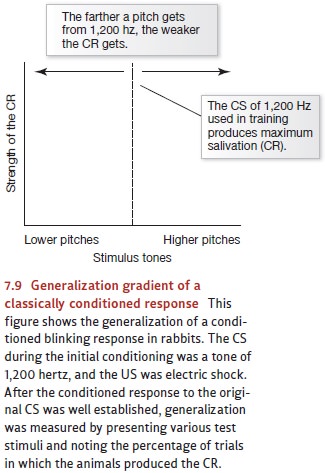Chapter: Psychology: Learning
Classical Conditioning: Generalization
GENERALIZATION
In Pavlov’s early experiments,
animals were trained with a particular CS—the sound of a bell or metronome, for
example—and then later tested with that same stimulus. But Pavlov understood
that life outside the lab is more complicated. The master’s voice may always
signal food, but his tone of voice varies from one occasion to the next. The
sight of an apple tree may well signal the availability of fruit, but apple
trees differ in size and shape. Because of these variations, animals must be
able to respond to stimuli that aren’t identical to the original CS; otherwise,
the animals may obtain no benefit from their earlier learning.
It’s not surprising, therefore,
that animals show a pattern called stimulusgeneralization—that
is, they respond to a range of stimuli, provided that these stimuliare similar
enough to the original CS. Here’s an example: A dog might be conditioned to
respond to a tone of a particular pitch. When tested later on, that dog will
respond most strongly if the test tone is that same pitch. But the dog will
also respond, although a bit less strongly, to a tone a few notes higher. The
dog will also respond to an even higher tone, but the response will be weaker
still. In general, the greater the difference between the new stimulus and the
original CS, the weaker the CR will be. Figure 7.9 illustrates this pattern,
called a generalization gradient. The
peak of the gradient (the strongest response) is typically found when the test
stimulus is identical to the conditioned stimulus used in training. As the
stimuli become less like the original CS, the response gets weaker and weaker
(so the curve gets lower and lower).

Related Topics